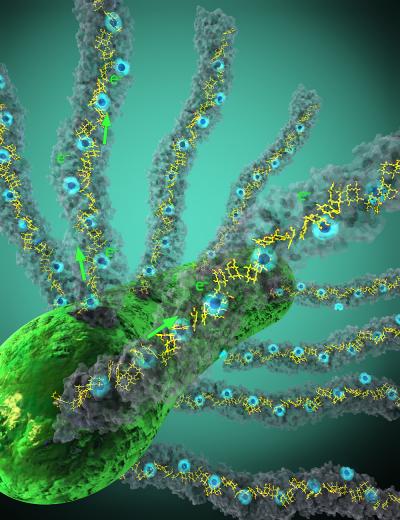Bacterial nanowire mystery solved

Nanowires project from bacteria to facilitate transfer of electrons Credit: Yale University
These nanowires enable the bacteria to perform environmentally important functions such as cleaning up radioactive sites and generating electricity. Scientists have long known that Geobacter make conductive nanowires – 1/100,000 the width of a human hair – but to date no one had discovered what they are made of and why they are conductive.
A new study by researchers at Yale, University of Virginia and the University of California at Irvine published April 4 in the journal Cell reveals a surprise: the protein nanowires have a core of metal-containing molecules called hemes.
Previously nobody suspected such a structure. Using high-resolution cryo-electron microscopy, the researchers were able to see the nanowire's atomic structure and discover that hemes line up to create a continuous path along which electrons travel.
“This study solves a longstanding mystery of how nanowires move electrons to minerals in the soil,” said lead author Nikhil Malvankar, assistant professor of molecular biophysics and biochemistry at Yale and a faculty member at the Microbial Sciences Institute.
“It is possible we could use these wires to connect cells to electronics to build new types of materials and sensors.”
###
Edward Egelman of Virginia and Allon Hochbaum of UC-Irvine are other senior authors. Fengbin Wang of Virginia and Yale's Yangqi Gu and are co-first authors. Other authors are Yale's Patrick O'Brien, Sophia Yi, Sibel Ebru Yalcin, Vishok Srikanth, Cong Shen, Dennis Vu and UC Irvine's Nicole Ing.
Media Contact
All latest news from the category: Life Sciences and Chemistry
Articles and reports from the Life Sciences and chemistry area deal with applied and basic research into modern biology, chemistry and human medicine.
Valuable information can be found on a range of life sciences fields including bacteriology, biochemistry, bionics, bioinformatics, biophysics, biotechnology, genetics, geobotany, human biology, marine biology, microbiology, molecular biology, cellular biology, zoology, bioinorganic chemistry, microchemistry and environmental chemistry.
Newest articles

Silicon Carbide Innovation Alliance to drive industrial-scale semiconductor work
Known for its ability to withstand extreme environments and high voltages, silicon carbide (SiC) is a semiconducting material made up of silicon and carbon atoms arranged into crystals that is…

New SPECT/CT technique shows impressive biomarker identification
…offers increased access for prostate cancer patients. A novel SPECT/CT acquisition method can accurately detect radiopharmaceutical biodistribution in a convenient manner for prostate cancer patients, opening the door for more…

How 3D printers can give robots a soft touch
Soft skin coverings and touch sensors have emerged as a promising feature for robots that are both safer and more intuitive for human interaction, but they are expensive and difficult…





















